
Due to COVID-19, the number of people experiencing extreme food insecurity globally increased by an estimated 45 million from February to June 2020. Aquatic foods are key to revitalizing stalled food systems.
The onset of COVID-19 disrupted food value chains and reversed years of progress on key development indicators. The pandemic induced shocks to food systems globally, but particularly impacted value chains in food insecure regions: the number of people experiencing extreme food insecurity increased by an estimated 45 million from February to June 2020 alone.
Fish and aquatic food value chains in particular must be revitalized to support the health and nutrition of vulnerable peoples. Capture fisheries and aquaculture represent a vital source of food, employment, and income for millions of people in Africa and Asia.
Renewed commitments to small-scale fish and aquatic food production can both aid economic recovery and tackle hunger in low-income nations, according to a new WorldFish research publication.
Through interviews with value chain actors on the ground in multiple countries across Africa and Asia, the study explicates novel challenges posed by the pandemic to aquatic food producers and the associated policy responses.
Throughout 2020, researchers conducted a high frequency longitudinal survey with 768 respondents in Bangladesh, Egypt, India, Myanmar, and Nigeria. The aim of the survey was to assess the supply, demand, and market value of aquatic foods, monitoring changes throughout the year as COVID-19 containment strategies emerged.
The information gained provides insights into the pathways by which the crisis has affected aquatic food value chain actors, the scale of those impacts, and how they have adapted. These findings can shape policy recommendations aimed at mitigating impacts in the present, assisting recovery, and building a more resilient aquatic food system in the future.
In this interview the publication’s lead researcher and WorldFish’s Global Lead for Social and Economic Inclusion, Ben Belton, discusses what the findings mean for the future of aquatic foods and global food security.

What are the findings from the multi-country study?
Our findings indicate that COVID-19 and associated containment measures severely disrupted aquatic food value chains, but effects on the supply and availability of aquatic foods were quite short-lived. In fact, we determined that COVID-19 has mostly exacerbated pre-existing inequalities, and formal assistance has been limited.
From our qualitative survey work in Bangladesh, we found that higher income consumers maintained the same diets pre- and post- pandemic, whereas poorer people sharply reduced their intake of animal-sourced foods like fish. However, we also discovered that some low-income households who grew their own fish, rice, or vegetables were more insulated from the shocks to food availability than poor households entirely dependent on purchased food.
What impacts has this seen on the availability and price of aquatic goods?
While the impacts on supply were only temporary, there have been prolonged impacts on demand, which has yet to recover to pre-pandemic levels. Demand for production inputs and labor also remains low, resulting in substantially lower incomes for small businesses and workers along the value chain as compared to 2019.
Due to the drop in demand, retail prices of aquatic food have declined over the course of the pandemic. However, the price of key productions inputs like commercial fish feed has risen. This reflects the challenges of doing business during the pandemic – operational costs are higher while retail value is lower.
How have value chain actors responded and adapted to market changes?
Aquatic food value chain actors have adapted to the challenge in diverse ways. To reduce production costs, many fish farmers have learned to use alternative and locally available inputs. Others have taken on loans, sought alternative employment, or reduced daily food consumption. Such coping strategies allow smaller producers and other actors to persist in the short run, but they are likely to undermine well-being and resilience long term.
Larger businesses appear to have greater capacity to adapt proactively, and these advantages may lead to increasing concentration of ownership or market share in parts of some value chains.
Who has been most impacted by the shocks to value chains?
Public health interventions and lockdown measures continue to play an important role in saving lives, but the resulting economic crisis disproportionately affects certain groups. Low-income actors and those in precarious occupations have proven most vulnerable to financial losses, food and nutrition insecurity, and health risks.
The economic slowdown from containment measures has also resulted in a growing number of business closures, either temporary or long-term. This trend may start to impact food availability and access along value chains and put further stress on undernourished people.
In the study you provide recommendations to address the immediate supply-side impacts of the pandemic. Which ones are key?
Firstly, keeping value chains functioning smoothly is necessary to prevent shocks to food systems. Logistical services, physical marketplaces, and input supply businesses should all be designated as essential and kept open and operating, with social distancing, sanitization, and personal protective equipment implemented to protect public health.
Workers in all segments of aquatic food value chains must also be deemed as essential. Special consideration should be given to mitigating the effects of lockdowns on migrant workers, who make up a significant part of the workforce in many aquatic food value chains.
It is also important to establish regular consultation between government, fisheries professionals, and relevant business associations to quickly identify emerging problems in aquatic food value chains and implement remedies.
As you said, there has not been much government assistance across the countries. However, when possible, how should it be directed?
Yes, emergency financial support to actors in aquatic food value chains has been limited. However, where such schemes are implemented, value chain actors including fish traders, fish transporters, and fish processors often received less attention than producers. All of these should be given the same priority and assistance.
Governments and aid organizations should also focus more on small and medium-sized enterprises. These are employing many more people than large enterprises and account for most of the aquatic food produced and traded in low- and middle -income countries.
In most of the countries studied, the reach of formal social safety nets appears to have been limited or patchy. However, if implemented widely, safety nets can play important roles in mitigating the impacts of shocks on the poor and vulnerable. How can we create robust safety nets?
Direct cash payments are one way to mitigate crises and have the potential to increase consumption of nutritious aquatic foods and stimulate demand for their production. Disbursement can be timed to coincide with implementation of lockdowns, or other periods of acute stress, and be targeted to poor or vulnerable groups, including women of reproductive age.
Food aid packages can also be distributed in food insecure regions or to particularly vulnerable groups such as refugees. Dried and preserved fish-based products are ideal for distribution as they are nutritious, culturally appropriate, convenient, and relatively low-cost. These products are long-lasting and circumvent the need for cold storage.
The study aims to revitalize aquatic food value chains to protect livelihoods and human nutrition, contribute to post-pandemic recovery, and promote resilience to future shocks. How can this be achieved?
Before the shock of the pandemic, there was already an extremely powerful case to be made for the importance of aquatic foods as a source of nutrition, livelihoods, employment and income in the Global South. The impacts of the COVID crisis on human development make that case even stronger. Renewed investments in critical infrastructure, along with human capacity and skills development, is needed to realize the sector’s potential.
The key challenge is to take COVID-19 as an opportunity to ‘build forward better.’ The crisis has helped to expose weaknesses and bottlenecks in global and national food systems and illustrated vividly which policy responses worked and which had unintended negative consequences. As such, there are many valuable lessons to learn for the future. We need to take the opportunity to analyse what happened and why.
There is a clear need for expanded social protection for the most vulnerable. Developing robust social safety nets will prevent large-scale slides into extreme poverty and food and nutrition insecurity when shocks do occur, helping to maintain the consumption of nourishing aquatic foods during crisis.
Read the full paper, COVID-19 impacts and adaptations in Asia and Africa’s aquatic food value chains.
